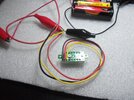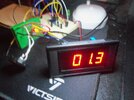Flashdrive34
New Member
HI TO ALL MEMBERS:
I was working on milliohm tester and needed a 200mv meter. So I purchased one of these 3 digit digital voltmeters and wanted to change it to 200mv meter or 300mv meter. Which ever would work to get it to 200mv or 300mv meter. With one meter I purchased it is 3 wire red is vcc black vdd and yellow is measure. You read from 0 to 30v full scale. Beyond 30v will destroy dvm. I also ordered 200mv meter from china which should be here in a month or less. I ordered few more dvm from ebay and case I could make work for my tester. It seems like these meters either use a 14 pin ic chip as adc or mcu for this meter. Does any one know how I can convert this meter to 200mv or 300mv full scale? Parameter
Dimensions(L * W * H): 30 * 11.7 * 9.2 mm
Opening Size: 23 * 10 mm
Display Type: 0.28" Red LED Tube
Measurement Range: 0-100V DC
Measurement Rate: ≥200ms/time
Power supply: DC 3-30V
Its a nice little meter thats why I would like to use it for my tester. Thanks for any help you can give me. Since I am 75 years old now guess I should give up on making testers. I wanted see if could use it to find dead shorts on circuit boards. Thanks for any help guys.
I was working on milliohm tester and needed a 200mv meter. So I purchased one of these 3 digit digital voltmeters and wanted to change it to 200mv meter or 300mv meter. Which ever would work to get it to 200mv or 300mv meter. With one meter I purchased it is 3 wire red is vcc black vdd and yellow is measure. You read from 0 to 30v full scale. Beyond 30v will destroy dvm. I also ordered 200mv meter from china which should be here in a month or less. I ordered few more dvm from ebay and case I could make work for my tester. It seems like these meters either use a 14 pin ic chip as adc or mcu for this meter. Does any one know how I can convert this meter to 200mv or 300mv full scale? Parameter
Dimensions(L * W * H): 30 * 11.7 * 9.2 mm
Opening Size: 23 * 10 mm
Display Type: 0.28" Red LED Tube
Measurement Range: 0-100V DC
Measurement Rate: ≥200ms/time
Power supply: DC 3-30V
Its a nice little meter thats why I would like to use it for my tester. Thanks for any help you can give me. Since I am 75 years old now guess I should give up on making testers. I wanted see if could use it to find dead shorts on circuit boards. Thanks for any help guys.










